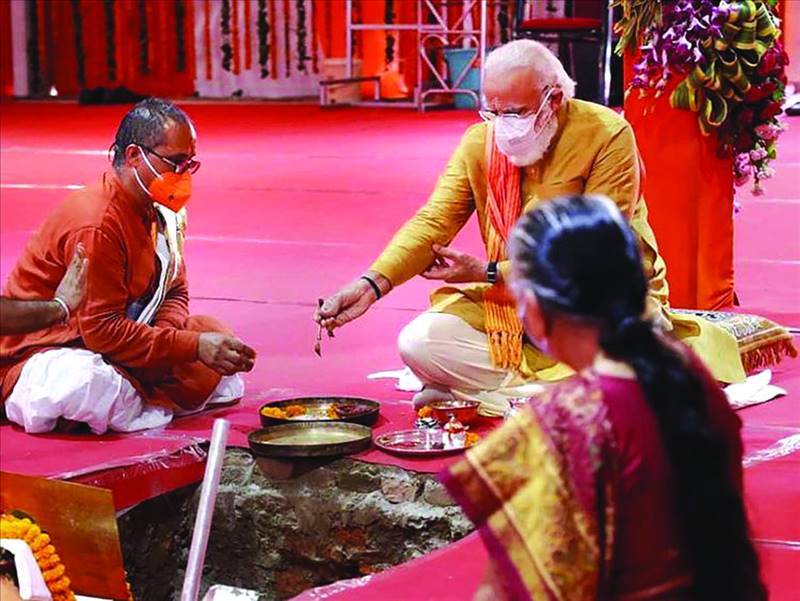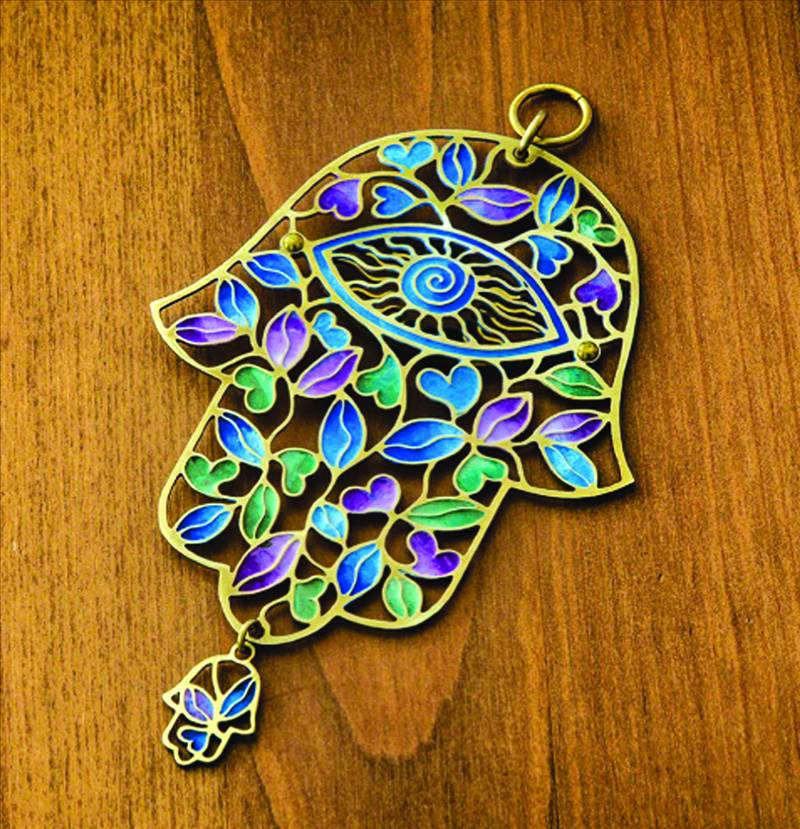
There is a weather worn poster for the American Sephardic Association that is glued to a now-shuttered storefront on my street. I make sure to pass it every morning I leave the house because the symbol for ASA is a khamsah, coincidentally my own favorite shape. The open palmed right hand is culturally sacred to both Jews and Muslims as a symbol of protection against the evil eye, and it dates from as far back as ancient Mesopotania (3500 BC-ish). You’ve probably seen it yourself: on charm bracelets, sculptures, paintings, prints, t-shirts, necklaces, belts, crowns, scepters, carpets, curtains, doors, lamp shades, arches, bed spreads and, once, as a twenty-foot backdrop to a drag queen’s musical rendition of “Talk to the Hand”. It has been called many things; the Hand of Ishtar, the Hand of Venus, the Hand of Mary, the Hand of Fatima, all variations of same theme: motherly protection.
I grew up wearing a silver version of it as a pendant through my later teenage years, a gift from my very Shia grandmother on my sixteenth birthday. The universality of the symbol appealed to me, and I found that If I felt stressed, anxious or scared, its presence relaxed me. In that way it worked like all talismans do, by brining focus back to the present moment with the trust that everything will be fine. I smile when I pass that poster for this reason – a smile for my memories, yes, but also for the joy of symbols. They are the essence of how we convey meaning. Think of arrows on airport signs, red crosses on hospitals and ambulances, or even the bitten Apple on your phone. It blows my mind that the shapes transcend barriers of language and, in many cases, time.
But symbols are not simply shapes with meaning. They can become repositories for the souls of entire nations, civilizations even: The Pyramids, The Hanging Gardens, the Colosseum, the Parthenon, the Hagia Sophia, later on the Eiffel Tower, Big Ben, Christ the Redeemer, the Washington Monument, even the Minar-e-Pakistan (such as she is). Each was or is treated as living embodiments of self importance. One of the reason that the 9/11 images remain with us even today is because the twin towers were those living buildings; they were soaring, phallic symbols of American might, and anyone who saw them fall on live television knew they were watching more than just collapsing buildings.
Earlier this week, when I saw video footage of that awful explosion in Beirut, I knelt on the floor and cried. The tears came unexpectedly, and left just as quickly. Maybe it was just the release of an accumulation of stress from the pandemic, but I had a feeling of witnessing a symbol of times, a fatal blow just when we all feel vulnerable, no matter where in the world we live.

I busied myself with work until later that day, while scrolling through newsfeeds, I saw another act of nationalist symbolism. This time it was Modi building a temple on the ruins of a mosque. Like everything which that little man does, it was designed to project a puffed up Hindutva triumphing over Islam. His brand of nationalism is no different to that of any fascist: add a reductive mix of toxic masculinity, stir with strong arming freedom of expression, and wrap up in historical fiction tightly enough that nothing else gets in. They did it in Mesopotamia too, just as in our own country. Old as the tricks may be, the effects - on sectarian harmony and political freedom in India - will be all too real.
All around us, things are falling apart. Great big things, things that have governed our ways of life for as long as there have been countries. Western centrism, white supremacy, toxic masculinity, institutionalized racism, American unilateralism, global colorism, hypocrisy and capitalist greed are all symbols of dominance that are swaying in the stillness of our stasis. I wish there was some Thing, some symbol I could hold onto as storm rages in these uncertain months. What I can say is later that same evening, when I was putting away some cartons, I spotted my old silver khamsa poking out of a plastic bag from home. And I smiled, briefly basking in that most universal symbol of faith: hope.
Write to thekantawala@gmail.com
I grew up wearing a silver version of it as a pendant through my later teenage years, a gift from my very Shia grandmother on my sixteenth birthday. The universality of the symbol appealed to me, and I found that If I felt stressed, anxious or scared, its presence relaxed me. In that way it worked like all talismans do, by brining focus back to the present moment with the trust that everything will be fine. I smile when I pass that poster for this reason – a smile for my memories, yes, but also for the joy of symbols. They are the essence of how we convey meaning. Think of arrows on airport signs, red crosses on hospitals and ambulances, or even the bitten Apple on your phone. It blows my mind that the shapes transcend barriers of language and, in many cases, time.
But symbols are not simply shapes with meaning. They can become repositories for the souls of entire nations, civilizations even
But symbols are not simply shapes with meaning. They can become repositories for the souls of entire nations, civilizations even: The Pyramids, The Hanging Gardens, the Colosseum, the Parthenon, the Hagia Sophia, later on the Eiffel Tower, Big Ben, Christ the Redeemer, the Washington Monument, even the Minar-e-Pakistan (such as she is). Each was or is treated as living embodiments of self importance. One of the reason that the 9/11 images remain with us even today is because the twin towers were those living buildings; they were soaring, phallic symbols of American might, and anyone who saw them fall on live television knew they were watching more than just collapsing buildings.
Earlier this week, when I saw video footage of that awful explosion in Beirut, I knelt on the floor and cried. The tears came unexpectedly, and left just as quickly. Maybe it was just the release of an accumulation of stress from the pandemic, but I had a feeling of witnessing a symbol of times, a fatal blow just when we all feel vulnerable, no matter where in the world we live.

I busied myself with work until later that day, while scrolling through newsfeeds, I saw another act of nationalist symbolism. This time it was Modi building a temple on the ruins of a mosque. Like everything which that little man does, it was designed to project a puffed up Hindutva triumphing over Islam. His brand of nationalism is no different to that of any fascist: add a reductive mix of toxic masculinity, stir with strong arming freedom of expression, and wrap up in historical fiction tightly enough that nothing else gets in. They did it in Mesopotamia too, just as in our own country. Old as the tricks may be, the effects - on sectarian harmony and political freedom in India - will be all too real.
All around us, things are falling apart. Great big things, things that have governed our ways of life for as long as there have been countries. Western centrism, white supremacy, toxic masculinity, institutionalized racism, American unilateralism, global colorism, hypocrisy and capitalist greed are all symbols of dominance that are swaying in the stillness of our stasis. I wish there was some Thing, some symbol I could hold onto as storm rages in these uncertain months. What I can say is later that same evening, when I was putting away some cartons, I spotted my old silver khamsa poking out of a plastic bag from home. And I smiled, briefly basking in that most universal symbol of faith: hope.
Write to thekantawala@gmail.com

